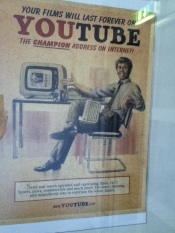There was some kerfuffle this year over the issue of students designing posters. Students in a short case study I wrote on blended learning participated at a stage of the case study with multimodal poster design (Glogster.com), incorporating research data, classroom annotated notes, videos, images and frameworks of syllabus knowledge.
The activity ticked the ed-tech boxes: collaborative, active, creative – students were mobile: out of the classroom compiling data, returning to the PC workshop to put it together with an enthusiasm that was uncharacteristic of that group (who were resitting English GCSE students). The tasks were authentic, as students made observational studies of language in ‘real world’ contexts, conducted Vox Pop interviews and surveys and posted the results on to ever-growing posters. At some point, a pause in this fervour was required where enough content was accumulated. Perhaps it came too late as the students surveyed their work with confusion.
Curating – a buzzword born of the culture and transposed to the classroom – is fashionable and fits with ideas of educational technologies, whence a central inquiry (as in Sutra’s – misguided- SOLE theory) has a plethora of sources cloistered to it from distributed hubs. Unfortunately, when the fun stops and essays – threads of thought structured into balanced perspectives, summaries and conclusions – begin, synthesis of so much disseminated knowledge becomes complex and students can easily revert to complancency.
This is the problem with, say, Padlet, as I see it. Students happily suspend details in documents of pretty colours and fonts.So much copied text, so many links, random photos and screenshots – but …so what?
The pixel becomes a postage stamp, the stamp becomes a poster, the poster becomes a quilt; as the whole grows, so the fine-grained nuanced detail simultaneously shrinks.
Revisiting such documents reminds me of a drunken night in China when I was 22. Staying at a hostel, myself and some other travelers were invited by the owner (via a bottle of scotch and several cans of paints) to create a mural on his cafe wall. Earnestly and diligently we obliged, becoming fevered in our endeavour, thinking ourselves like Boticelli creating a timeless fresco, painting late into the night before retiring to bed. In the morning… woah, the results were …like regurgitated whisky graffitied in technicolour on a subway wall. I can still recall the owners crestfallen face as he walked in, before he saw the funny side. Then invited us to leave.

Yet I admire watching the attention to detail and energy which students have spent in constructing posters and padlets, but there is often little purpose in process and content becomes extraneous. It’s difficult sometimes to still such enthusiasm. I’ve learned the hard way that cognitive dissonance is easily embedded in such content-heavy activities; students quickly become disorientated when trying to make sense of what has simply become a critical mass of information. This disorientation is (partly) what I call Social Media Fatigue, which has problematic consequences on self-esteem and sustained effort.
This is not to say there’s no point in curation activities. Representations of webs of information does not necessarily enable a schema, but can draw attention to salient detail where highlighted – selective curating. Mayer has written extensively of the cognitive impact of multimedia on memory, but a problem is Mayer takes a view of the learner as passive receptacle to multimedia information being presented to them as inducted. Mayer also frames his research entirely on long-term memory over other paradigms. Would the architecture involved in the active process of constructed content (by students) produce different results, especially where guided with proper signalling principles as instructed in a staged, rather than ‘throw-everything-at-the-wall’, process? Some recommendations for curating follow.

Recommendations that follow the bit before
- Curation is a method of archiving, but need to come with packaging instructions – as much for the signposting help of visitors as for those revisiting the collection at a later date and needing organisational pointers. A focused headline of what content is to be about will train the student’s attention of what to include.
- This might include ‘think-aloud’ activity accompanying students curation: e.g.students recording voice-overs, explaining what they are posting and why as they post the content. Audio recording can be done with Padlet or Explain Everywhere, but is too often an underused feature. “I’m posting this link as it includes a helpful example of how to apply the prosodics framework in other examples of analysis. I can use this in my own essay” and so on.
- Co-curation is another approach, where the teacher either posts first or guides what they want to see. This reduces redundant material, resulting in a specific structured approach, which reflects the desired ordering and organisation of content. For example, if the canvas is destined to support an essay, it may reflect a mapping of ideas, with systematic directions. “Open a dialogue box and show which quotes to include in paragraph 1 as Steinbeck characterising Lennie. Accompany with matching depictions of Lennie from stills of the film to illustrate your quote. Now open dialogue boxes containing alternative quotes representing Lennie.”
- A poster that becomes a mindmap of curated knowledge, research and ideas can be reordered by students into an essay structure or presentation, like one of those old-fashioned toy puzzles. In Padlet, structure can be reorganised easily through slide manouevring. Making it look more like the finished article of a staid-old essay can help improve selection of content for the final product and mastery of editing.

- Size is important, so students vote-up what they perceive as the more important content and reflect this in larger boxes, or by use of colours to highlight significance. However, use of space and continguity on the curation canvas is highly important for navigation, so care must be exercised that the visual organisation is not disorientating where different sizes and colours are used. Arrows and/or numbering linking content should also help with ordering.
- Scale-back and edit: revisit the padlet or poster and be judicious of what is extraneous, what can be treated to the magic bin symbol. This can result in a healthy debate of ownership of purposeful over pointless content.
- Navigating rich textual information is not straightforward, so summaries of highlighted information (while superficial to undertones) are helpful for curated content, with links to further information provided that explain (in audio recordings) what can be found and used in those sources.
- For long-term memory fanatics, testing of what was embedded as content into the poster or padlet is a feasible means of reinforcement, sort of like those old games where you put objects on a table and remove one and test observation and recall, but digital. As a starter: “Let’s recall what we have on our padlet so far.” Again, it would be worthwhile focusing students’ attention to ‘why’ certain content was on the poster – what is the link to the central question?
- Finally, one of the affordances of such technologies as Padlet is it’s collaborative functioning, so named labels of curators contributions will enable some analytics of who did what. I tend to think smaller groups help, rather than whole class creations which can be messier.
I think there is something in this post of overcoming other aspects of Social Media Fatigue – that of the ‘copy-and-paste’ approaches that students take, which sees a lack of interaction with ideas and knowledge where ‘content’ is separated from process (both practical and internalised definitions of the word). Better understanding of how students use and respond to content is the key to successful learning (and teaching), rather than simply churning information over like topsoil. Clearly, there are more undertones to this, involving questioning and rich discussion. This post hasn’t sought to address that, which requires a more complex dialogue.


 “We shall not cease from exploration, and the end of all our exploring will be to arrive where we started and know the place for the first time.” T.S.Eliot
“We shall not cease from exploration, and the end of all our exploring will be to arrive where we started and know the place for the first time.” T.S.Eliot








